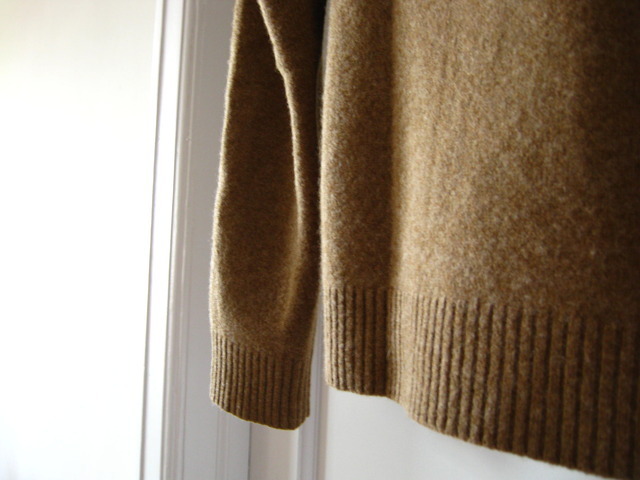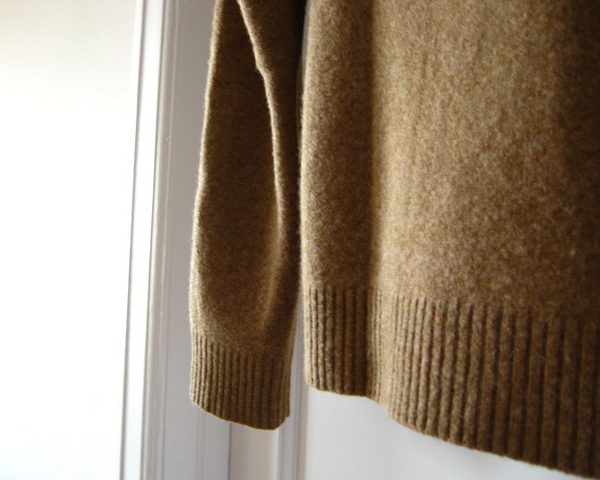
The best time to purchase sweaters is at the end of the season, when the fall/ winter stock gets discounted by fifty percent or more. The best time to shop for sweaters, however, is now, so that you can give yourself a few months time to figure out what you want and not be rushed into impulse buys come January. So, if you’re out browsing for sweaters, I’d suggest the following:
Low- to mid-tier purchases: If your budget is limited, I recommend aiming for sweaters made out of lambswool, Shetland, or merino wools. The first two, all things being equal, are harder-wearing. I also think they can often have more visual depth in their texture and color than most, lower-end merinos, which can be useful if you want to wear the sweater without a jacket. The sweater pictured above really shows off the nice lofty nap on lambswool, I think.
High-end purchases: If your budget is over $350 or so, consider cashmere. The problem with cashmere below this mark – at least at full retail prices – is that they’re often poorly made. Cashmere is expensive, so when a company is selling a cashmere sweater for under $350 or so, it means they’ve likely skimped on the construction. That can mean shorter fibers used for the yarns, which will result in more breakages and pilling, or thin, loosely knitted fabrics, which will lose their shape over time. Better, I think, to stick to lambswool, Shetlands, and merinos, rather than be tricked into the allure of “cheap” cashmere.
Checking for quality: It’s difficult to determine a sweater’s true quality without having actually owned it for a few years. Nothing can substitute for experience. There are a few things, however, that you can do to make an educated guess. On cashmere, try rubbing the fabric between your fingers for a bit, and see if a light, oily residue has been left on your hands. If there is, that means the fabric was treated with a kind of emulsion, and is probably of low quality. On everything else, see if the sweater has been knitted densely, and check the elasticity of the collars and cuffs. It’s difficult to convey online exactly what level of quality to look for – which is why I think you should browse the inventory at a high-end store – but generally, if you think the sweater might lose its shape easily, it probably will.
Altering knits: Ideally, you should buy something that fits perfectly off-the-rack, but some knits can be altered if you have a good alterationist. On sweaters with side seams, I’ve found it’s easy to take in the body without too much trouble. You can read my post on knit alterations here.
Getting rid of pills: Every sweater, no matter what the quality, will pill to some degree. The question is just how much and how quickly. To take care of pills, I recommend using a sweater shaver. I use this one and it works decently well, though there are probably better ones on the market.
Where to buy: I can’t give a full list of every place that stocks good sweaters, but I can make a few suggestions based off of my experiences. On the high end, I really like Inis Meain, Drumohr, Drake’s, John Smedley, and William Lockie (the last of which you can buy through Heather Wallace). For more affordable purchases, I’ve had good experiences with Brooks Brothers, Club Monaco, and Howard Yount. The first two often do significant mark-downs throughout the season, which is when I think you should buy. Club Monaco also gives students an extra 20% off if they can show a student ID in-store or give a university email address online. I’ve picked up their basic v-neck sweaters before for about $45, and find them to be of a good value.
